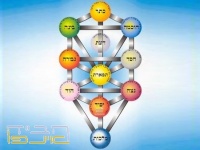Sefiras HaChesed: Difference between revisions
(→Odem) |
No edit summary |
||
| Line 1: | Line 1: | ||
Sefiras HaChesed is the first of the six middos (emotional attributes) and the fourth among all ten sefiros. | {{Ten Sefiros}} | ||
'''Sefiras HaChesed''' is the first of the six middos (emotional attributes) and the fourth among all ten sefiros. | |||
The inner meaning of Sefiras HaChesed is ahavah (love), which represents the essential desire to give. Sefiras HaChesed is "yoma d'azil im kulhu yamim" (the day that "goes" with all days), as it is the foundation for all other middos and participates with them, for the middah of chesed is included in all middos. | The inner meaning of Sefiras HaChesed is ahavah (love), which represents the essential desire to give. Sefiras HaChesed is "yoma d'azil im kulhu yamim" (the day that "goes" with all days), as it is the foundation for all other middos and participates with them, for the middah of chesed is included in all middos. | ||
Latest revision as of 06:06, 11 March 2025
| Sefiras HaChesed | |
|---|---|
 Chochma • Binah • Daas Chesed • Gevurah • Tiferes Netzach • Hod • Yesod • Malchus |
Sefiras HaChesed is the first of the six middos (emotional attributes) and the fourth among all ten sefiros.
The inner meaning of Sefiras HaChesed is ahavah (love), which represents the essential desire to give. Sefiras HaChesed is "yoma d'azil im kulhu yamim" (the day that "goes" with all days), as it is the foundation for all other middos and participates with them, for the middah of chesed is included in all middos.
Its Essence[edit | edit source]
Sefiras HaChesed's essence is ahavah and its branches, and the desire to bestow goodness and kindness upon others. The nature of this bestowal is not according to the recipient's vessels, but rather the bestowal itself.
Sefiras HaChesed in the System of Sefiros[edit | edit source]
Sefiras HaChesed is the first of the middos - the six sefiros of Chesed, Gevurah, Tiferes, Netzach, Hod, and Yesod.
In Pardes Rimonim, it is explained that the word "hagedulah" in the verse "Yours, Hashem, is the hagedulah and the gevurah" refers to Sefiras HaChesed.
Regarding Sefiras HaChesed, it is said that it is "yoma d'azil im kulhu yomin" (the day that "goes" with all days). This means that Sefiras HaChesed participates and continues together with all other middos, since the general concept of middos is the relationship to the external, and Sefiras HaChesed - which is the desire to give - is the foundation and basis for all other middos.
It is considered a continuation of Chochmah in the right line. The concept is that just as chesed is like water that flows from high to low, so too chesed's essence is bestowal from high to low. Similarly, the love that extends from chesed is like water, unlike the love that extends from gevurah which is like fire.
In Pasach Eliyahu, Sefiras HaChesed is called "droa yemina" (right arm), which represents bestowal. Sefiras HaChesed is connected to the right hand as it represents expansive bestowal from the right side. Sefiras HaChesed is called "droa yemina," in contrast to Sefiras HaGevurah which is called "droa smala," and both are like arms extending from the "gufa" which is Sefiras HaTiferes.
Ahavah and chesed are referred to as masculine, as it says "remember His kindness," unlike the middah of gevurah which is called feminine, "a woman who fears Hashem."
The explanation of midas hadin is the aspect of gevurah, meaning strength, where the life-force from Ohr Ein Sof comes with greater intensity than the aspect of chesed which flows downward but comes with coolness. However, with gevurah, the life-force from Ohr Ein Sof comes with tremendous intensity. Therefore, when it descends through hishtalshelus, it becomes din - one who is not worthy to receive the flow cannot receive it because the life-force flows with great intensity. Unlike chesed, where the life-force comes with coolness and can flow and expand downward, gevurah is life-force with intensity.
The name E-l corresponds to the middah of chesed.
Avraham Avinu[edit | edit source]
Avraham Avinu's essence was the middah of chesed, and as it is written in the Midrash that as long as Avraham was in the world, Sefiras HaChesed did not need to function.
Odem[edit | edit source]
The stone called Odem - one of the Choshen stones - receives from Sefiras HaChesed and therefore Reuven was engraved upon it, because Reuven represents the aspect of chesed.
Sometimes it is called Odem from the word for redness - fire - intense love like flames of fire, which is the aspect of Reuven.